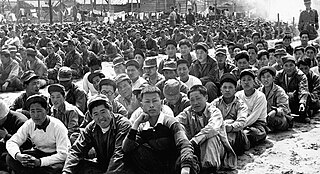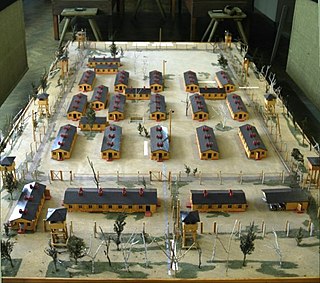
The Great Escape is a 1963 American epic war film starring Steve McQueen, James Garner and Richard Attenborough, and featuring James Donald, Charles Bronson, Donald Pleasence, James Coburn, and Hannes Messemer. It was filmed in Panavision.

A prisoner-of-war camp is a site for the containment of enemy combatants captured by a belligerent power in time of war.

Oflag VII-A Murnau was a German Army POW camp for Polish Army officers during World War II. It was located 2 km (1.2 mi) north of the Bavarian town of Murnau am Staffelsee.

Escape to Victory is a 1981 American sports war film directed by John Huston and starring Sylvester Stallone, Michael Caine, Max von Sydow and Pelé. The film is about Allied prisoners of war who are interned in a German prison camp during the Second World War who play an exhibition match of football against a German team.

In Germany, stalag was a term used for prisoner-of-war camps. Stalag is a contraction of "Stammlager", itself short for Kriegsgefangenen-Mannschaftsstammlager.

The Cowra breakout occurred on 5 August 1944, when 1,104 Japanese prisoners of war attempted to escape from a prisoner of war camp near Cowra, in New South Wales, Australia. It was the largest prison escape of World War II, as well as one of the bloodiest. During the escape and ensuing manhunt, 4 Australian soldiers and 231 Japanese soldiers were killed. The remaining escapees were re-captured and imprisoned.

Oflag X-B was a World War II German prisoner-of-war camp for officers (Offizierlager) located in Nienburg am Weser, Lower Saxony, in north-western Germany. Adjacent to it was the enlisted men's camp (Stammlager) Stalag X-C.

Oflag II-C Woldenburg was a German World War II prisoner-of-war camp located about 1 kilometre (0.62 mi) from the town of Woldenberg, Brandenburg. The camp housed Polish officers and orderlies and had an area of 25 hectares with 25 brick huts for prisoners and another six for kitchens, class-rooms, theater, and administration.

Stalag V-A was a German World War II prisoner-of-war camp (Stammlager) located on the southern outskirts of Ludwigsburg, Germany.
The 1986 Los Angeles Rams season was the franchise's 49th season in the National Football League, their 39th overall, and their 41stin the Greater Los Angeles Area. The season began with the Rams looking to improve on their 11–5 record from 1985, which ended with them getting shut out by the Chicago Bears in the NFC Championship Game, 24–0. The Rams began the season with three straight wins against the St. Louis Cardinals, San Francisco 49ers, and Indianapolis Colts. However, in Week 4, the Philadelphia Eagles (0–3) upset the Rams, 34–20. The Rams would then win four of their next five, including a 20–17 win over the Bears in a rematch of the NFC Championship Game. The Rams would then close out the season with losses in four of their final seven games to end the year 10–6, good enough for second place in the NFC West behind the 49ers (10–5–1). In the playoffs, the Rams lost to the Washington Redskins, 19–7, in the NFC Wild Card Game to end the season with an overall record of 10–7.

Camp Douglas was an internment camp for Prisoners of War (POW) during World War II, located in the city of Douglas, Wyoming, United States. Between January 1943 and February 1946 in the camp housing first Italian and then German prisoners of war in the United States. While there are few remaining structures, the walls of the Officer's Club were painted with murals by three Italian prisoners. These paintings depicting western life and folklore are now registered with the United States Department of the Interior National Park Service on the National Register of Historic Places. The story of this POW camp is an important part of the history of the town of Douglas.
The Battle of Bowmanville was a 1942 revolt in the Bowmanville prisoner of war camp, Ontario, Canada. The prisoners, most of whom were higher-ranking German officers, objected to the intended shackling of 100 prisoners. The battle lasted for three days.

Oflag II-A was a German World War II prisoner-of-war camp located in the town of Prenzlau, Brandenburg, 93 kilometres (58 mi) north of Berlin.
Whitewater was a labour camp for German prisoners-of-war in Riding Mountain National Park, Manitoba. Operating from 1943 to 1945, the camp was built on the northeast shore of Whitewater Lake, approximately 300 kilometres (190 mi) north-west of Winnipeg. The camp consisted of fifteen buildings and housed 440 to 450 prisoners of war.
Camp Aliceville was a World War II era prisoner of war (POW) camp in Aliceville, Alabama. Its construction began in August 1942, it received its first prisoners in June 1943, and it shut down in September 1945. It was the largest World War II POW camp in the Southeastern United States, holding between 2,000 and 12,000 German prisoners at any one time.

Der Ruf or The Call was a German language newspaper published in Fort Kearny in Narragansett, Rhode Island during World War II by captured prisoners of war (POWs). It was distributed to about 140 other POW camps in the United States. After returning to Germany, two of the former POWs founded a German newspaper of the same name.
Camp Opelika was a World War II era prisoner of war (POW) camp in Opelika, Alabama. Its construction began in September 1942 and it shut down in September 1945. The first prisoners, captured by the British, were part of General Erwin Rommel's feared Africa Corps. It held approximately 3,000 German prisoners at any one time.
The 1917 Camp Lewis football team represented the United States Army's 91st Division in the 1917 college football season. The team was based at Camp Lewis in Tacoma, Washington, and compiled a 5–2–1 record. Both losses came against California's Mare Island Marines, including a rematch in the 1918 Rose Bowl.













